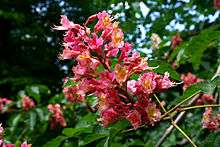Aesculus × carnea
| Red horse-chestnut | |
|---|---|
 | |
| Scientific classification | |
| Kingdom: | Plantae |
| Clade: | Angiosperms |
| Clade: | Eudicots |
| Clade: | Rosids |
| Order: | Sapindales |
| Family: | Sapindaceae |
| Genus: | Aesculus |
| Species: | A. × carnea |
| Binomial name | |
| Aesculus × carnea Zeyh. | |
Aesculus × carnea, or red horse-chestnut,[1] is an artificial hybrid between A. pavia (red buckeye) and A. hippocastanum (horse-chestnut). The origin of the tree is not known, but it probably first appeared in Germany before 1820. The hybrid is a medium-size tree to 20–25 m tall, intermediate between the parent species in most respects, but inheriting the red flower color from A. pavia. It is a popular tree in large gardens and parks.
Cultivars
- 'Briotii' (named in 1858 to honor Pierre Louis Briot, the nurseryman at Trianon-Versailles near Paris, France) This is the most commonly seen cultivar which has 10-inch tall, deep rosy flowers and matures as a smaller tree.[2]
- 'O'Neil', which produce larger (10–12 inch) panicles with brighter red flowers.
- 'Fort McNair' (named from where it was selected) it has dark pink flowers with yellow throats and resists leaf scorch and leaf blotch.
- 'Pendula' with arching branches.[3]
- 'Plantierensis' which has intense rose pink flowers with yellow throats and does not set fruit, which makes it less messy.[4]
References
- ↑ "BSBI List 2007". Botanical Society of Britain and Ireland. Archived from the original (xls) on 2015-01-25. Retrieved 2014-10-17.
- ↑ "Aesculus × carnea 'Briotii'". Royal Horticultural Society. Retrieved 25 July 2013.
- ↑ Govaerts, R., Michielsen, K. & Jablonski, E. (2011). Untraced Weeping Broadleaf cultivars: an overview. Belgische Dendrologie Belge Archived 2012-03-22 at the Wayback Machine. 2009: 19–30.
- ↑ Roth, Susan A. (2001). Taylor's guide to trees. Boston, MA: Houghton Mifflin Harcourt. p. 408. ISBN 978-0-618-06889-0.
| Wikimedia Commons has media related to Aesculus × carnea. |
This article is issued from
Wikipedia.
The text is licensed under Creative Commons - Attribution - Sharealike.
Additional terms may apply for the media files.